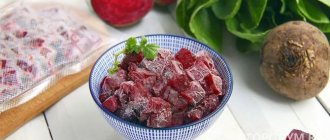Fresh food is the basis for quality nutrition. But, unfortunately, most of us cannot boast of eating exclusively fresh foods. That is why we use various devices to increase the shelf life of food. These include dryers for vegetables and fruits, refrigerators, freezers, etc.
The storage periods and conditions for different food products vary greatly. While some foods will remain edible for months if stored at room temperature, others need lower temperatures to maintain freshness, and others need to be frozen altogether.
What foods can be frozen in the freezer?
Traditionally, the freezer in the house is filled with meat, ice cream or semi-finished products are stored there.
At best, particularly thrifty housewives can freeze vegetables and fruits. Surprisingly, a much larger number of products can be frozen and used after defrosting. In this article we will tell you what else you can store in the freezer to save time and go to the store less often and preserve the quality of your food longer.
Vegetables
Frozen vegetables can last longer than just sitting on a shelf in the refrigerator.
Can be stored frozen:
- carrot,
- cabbage,
- zucchini,
- pepper,
- potato,
- broccoli,
- beans,
- and much more.
Before freezing, it is better to chop or chop vegetables in the form in which you plan to use them and place them in a plastic zip bag so that the vegetables do not absorb the odors of other foods stored in the refrigerator. You can also freeze herbs and greens and use them to prepare soups and main courses. If the freezer size allows you to freeze finely chopped greens in a glass jar, it will be convenient to take it from there.
Fruits
Fresh fruits without blemishes are suitable for freezing; check for worms. Cut them the same way as vegetables and put them in a ziplock bag. Use for fruit salads, cereals, desserts throughout the year.
Berries
Fresh frozen berries - strawberries, raspberries, currants, blueberries, blueberries - are a source of vitamins throughout the year. You can eat them defrosted or cook them into compote or add them to dessert dishes.
Mushrooms
Another product that can be perfectly stored frozen. Champignons, saffron milk caps, chanterelles, porcini mushrooms must first be peeled and washed, cut or frozen whole small ones, dried from moisture on a towel, and then frozen in a separate bag.
Honey
Oddly enough, natural honey does not lose its properties when frozen. If you rarely use honey in food, you can preserve it longer by freezing the product. It is most convenient to pour it into plastic measuring containers to use the treat for tea and other drinks. The harvester can be used to freeze other bee products, molasses, and brown sugar.
Cheeses
Hard cheese, such as Parmesan, is best stored frozen. If you are using grated cheese for spaghetti, you can first grate it or grind it in a food processor before freezing.
If the cheese is not hard, you can put a few tablespoons of corn or wheat flour in the bag. The flour will absorb excess moisture and the cheese will not stick together, its taste and smell will not change when defrosted.
Milk
If you have a lot of milk and are afraid it will go bad before you use it, freeze the excess milk. Thawed milk retains all its properties and is stored longer in the freezer, or simply in the refrigerator.
Milk can be frozen in glass bottles and jars or soft zip bags.
Kumis
Similarly, you can freeze a healthy product - kumiss. When defrosted, all nutritional properties will be preserved. Do not add kumiss to the very top so that it does not spill out when frozen.
Cottage cheese
Cottage cheese is a quickly perishable fermented milk product; to preserve it longer, you can use the freezing method. It can be stored in a ziplock bag in the freezer for up to six months and used for cheesecakes, pie fillings and pancakes.
Serum
Likewise, whey can be stored in the freezer for longer preservation.
Eggs
You can freeze it raw in three ways:
- entirely,
- separately yolk,
- separately protein.
With any method, the eggs are freed from the shell, otherwise it will simply crack and you will have eggs that will be mixed with the shell.
To defrost properly, place the eggs in the refrigerator and use them after they are completely thawed.
Do not use thawed eggs raw; use eggs for cooking.
You should not freeze boiled eggs.
Sour cream
Sour cream can be stored in the freezer for up to three months. Before freezing, think about what you will use thawed sour cream for, since it will most likely separate and change its taste; it is better to use it for sauces, dough and other dishes.
Meat
It is convenient to purchase raw meat in a store on sale, having previously divided it into separate elements: minced meat, steaks, etc., as well as types: pork, beef, it is better to store separately.
Marinated meat for barbecue or frying can also be frozen until needed.
You can also store cooked meat, such as boiled beef and chicken.
You can cook cutlets and freeze them as a home-made semi-finished product.
Fish
You can make homemade fish fingers. They are tastier and healthier than store bought ones. Roll the cut pieces of fish in breading and freeze as is. Slightly thawed fish fingers can be fried almost immediately.
Caviar
If you have a modern freezer with a super freeze function, you can try to freeze caviar, but keep in mind that the taste of the product will change after defrosting.
Bird
A bird, that is, a whole carcass, can be frozen whole, but if you plan to use not the whole bird for food, then it is better to freeze the breast fillet, legs, back and wings separately. To roast a whole carcass, it is better to use a fresh one, it will be juicier.
How to determine the quality of semi-finished products?
To determine the quality of a product, you first need to evaluate its appearance, taste, consistency and smell. When inspecting the packaging, be sure to pay attention to the absence of scratches, cracks and tears. Semi-finished products are sold in stores both fresh and frozen. In the first case, the surface should not be windy and slightly damp. Such products are sold without tendons and external films. In products made from pork and lamb, the presence of a subcutaneous layer is acceptable, but its thickness should not exceed 1 cm.
The color of breaded or chopped semi-finished products should visually be in the range from light yellow to light brown. The coating of the product with rusk flour is uniform over the entire area, while the presence of a putrid, moldy odor is unacceptable. Well-frozen products should make a distinct sound when tapped.
What ready-made meals can be frozen?
You can also freeze ready-made dishes, for example, fried cutlets tolerate freezing well.
Cream soups also retain their taste properties after defrosting.
You can freeze the broth to preserve it for making soups.
Ready-made pancakes, cabbage rolls, pasties, muffins, pies, dumplings, manti can be stored either raw or ready-made in the freezer.
Is it possible to store salty foods in the freezer?
You can store foods containing salt in the freezer. The only thing is that you should not store marinades; most likely, when defrosted, the taste of the pickles will change for the worse.
What foods can be frozen only whole or chopped or grated?
Here we can advise you to focus on the form in which you will need the frozen product. If you need chopped vegetables for frying, chop them before freezing. If you need whole peppers for the filling, freeze them whole with the cores cut out.
Also, be guided by the size of your freezer so that everything fits; it is more convenient to store it in cut and grated form.
What foods can be frozen for a longer period, for example for the winter?
Almost all vegetables, fruits, meat, fish, poultry, semi-finished products, and mushrooms can be frozen for the whole winter.
What foods should not be frozen in the freezer?
You cannot freeze boiled eggs; boiled egg whites acquire a disgusting taste after freezing. Do not freeze mayonnaise, cream cheese, carbonated drinks, canned fish and meat.
Defrosting features
If the freezing was slow and gradual, the milk should not be boiled after defrosting. The protein in the product will be destroyed and the drink will curdle into flakes.
Thawed milk curdles faster than fresh milk. Therefore, it is better to use it for preparing dough or other dishes. Fresh milk is more suitable for drinking.
to defrost milk :
- remove the container and leave to defrost at room temperature;
- place the container with the drink in the refrigerator for several hours;
- Immerse the container with frozen milk first in cold and then in warm water.
Organizing food storage in the freezer
What temperature foods are recommended to be placed in the freezer?
Of course, only freeze refrigerated foods. Hot and warm can cause damage to the freezer.
Dishes and packaging: what to freeze food in the freezer
Now there is a wide variety of packaging for storing food, from simple bags to vacuum containers. Choose containers depending on your budget and food preservation properties.
Freezing containers
You can store vegetables, fruits, berries, as well as home-cooked semi-finished products in them.
Glass containers
Glass is suitable for juices, milk, kumiss.
Glass jars are great for storing herbs and chopped spices.
Boxes for storing food in the freezer
Some refrigerator manufacturers have special plastic boxes for freezer storage, which are also convenient to use for freezing. Products in such boxes do not mix.
Is it possible to store food in foil in the freezer?
Use only thick foil, as thin food foil can crack when frozen and your food will freeze together in the foil, which will turn into aluminum shavings.
Vacuum bags
Modern zip bags, which can be bought in any supermarket, preserve food well, do not allow odors to pass through, and are easy to open and close.
Film
Cling film may be an option if you do not plan to store food wrapped in it all winter, since the film may crack from frost during long-term storage.
Paper
For lack of anything better, you can wrap food in paper. Please note that paper will not protect food from foreign odors or moisture.
How to distribute food on freezer shelves
Freezing food is not that difficult. It is more difficult to distribute food throughout the freezer so that it does not interfere with each other, so that it is convenient to take out food to defrost and put it back.
Place closer those products that you need most often: spices, herbs, vegetables, fruits, meat. Put away those foods that you plan to store all winter.
Setting the optimal temperature
If you store meat and fish products in the freezer, then it is better to set the temperature around -18-20 degrees Celsius.
If you don’t have meat products in the freezer, then -13-15 degrees will be enough to freeze the products and keep them frozen for a long time.
How to keep food close to each other in the freezer
If you store all your food in vacuum bags that won't tear and won't let in odors, then the strict rules of not putting anything nearby can be avoided.
If not, then place meat and fish products separately from fruits and vegetables. Milk and dairy products should not come into contact with strong-smelling products.
Why food can spoil and lose its value in the freezer
This is mainly due to the liquid contained in the products. When frozen, the crystalline structure of this liquid changes, changing the taste of the product. Some foods may only slightly change the taste, such as frozen bananas, while some may become almost completely tasteless, such as sour cream or cottage cheese.
Package
Regular plastic bags and cling film will not work. In the freezer they will crumble and break from the cold. We need dense polyethylene. These can be special bags, such as these are now sold, or simply dense bags, for example, soft milk packaging often gets a second life in the freezer.
How to store food in the refrigerator. Infographics Read more
Shelf life of main products in the freezer
| Products | Shelf life in the freezer |
| Berries, greens | 24 months |
| Fruits vegetables | 24 months |
| Milk | 30 days |
| Cottage cheese | 30 days |
| Fish | 3-6 months |
| Butter | 6 months |
| Hard cheese | 6 months |
| Minced meat | 4 months |
| Sausage, bacon, ham | 2 months |
"Multicold" - refrigerated warehouses in Moscow and the Moscow region
Our company provides storage services for products in multi-temperature warehouses. We have more than 185 thousand m² of warehouse space that can be rented for a long term. All warehouses are built in accordance with current standards, meet sanitary and hygienic requirements, and are equipped with modern refrigeration equipment. The complexes are under 24-hour security, and the performance of all systems is regularly monitored.
We work with food suppliers, trading companies, logistics centers, etc. Products are stored under proper conditions. For convenience, you can rent an office together with a warehouse directly on the territory of the agricultural hub.
To find out more about renting refrigerated, freezing warehouses or safekeeping services, please call.
User Questions:
Freezer does not freeze food
Most likely the freezer is faulty or not sealed.
Is it possible to turn on the freezer without food?
If the freezer is built into the refrigerator, then it will not be possible to disconnect it separately from all other chambers.
Why does snow form on food in the freezer?
Wet foods in a freezer without a No Frost system will be covered with frost, and in especially old refrigerators, a layer of snow.
What to do if the food in the freezer smells of freon?
Only if you do not have an old Soviet refrigerator, this is not the smell of freon, since it does not smell like a refrigerant. Most likely it is the smell of spoiled food or dirt from food debris on the surfaces of the chamber. Remove any bad-smelling foods, unplug the refrigerator, and clean the inside.
Why doesn't food freeze in the freezer?
Most likely due to a faulty freezer. Or if the food is in it less than the time required for freezing the product, then the product simply has not had time to freeze yet. All freezing times are approximate and may vary from refrigerator to refrigerator.
Food in a broken freezer has gone rotten, how can you remove the smell?
Empty the food first, then wipe down all surfaces with water and hydrogen peroxide. A vinegar solution (8 parts water, 1 part vinegar) can also help. Or use ready-made refrigerator cleaning products.
How to choose an inexpensive, but practical and reliable freezer for your home
Give preference to proven and well-known brands. The recommended freezer volume for a family of 3-4 people is a 200 liter freezer. Choose equipment with favorable energy consumption A+ and A++. If you need additional functions, then select “extra freezing” and the auto temperature preservation mode during a power outage.
Why do food in the freezer become covered with frost?
This may indicate a malfunction of the refrigerator, or the cooling mode is set incorrectly.
Why does food from the freezer smell like a refrigerator?
Frozen foods absorb odors well in a confined space like a freezer, which is why it is so important to store them in vacuum packaging.
Can I store food in the freezer in a glass jar?
Yes, it is quite possible to store liquid and bulk products in glass. The lid should fit tightly and not let air through.
Can I put hot food in the freezer?
No, this may damage the refrigerator.
Serving Size
Another important criterion that affects the time and quality of freezing is the size of the product. Industrial low-temperature warehouses allow freezing quite large volumes of products. However, the larger the portion size, the longer it will take to freeze it completely. Therefore, it is customary to freeze portioned pieces, which, when the temperature drops sharply, freeze evenly - from the edges to the center.
Freezing power also matters. Each freezer compartment is designed for a certain volume of products. You cannot put more goods in it, as this can significantly affect the quality of freezing. Also, you should not place products that require different freezing conditions in the same compartment.
Meat and poultry
Before freezing, it is better to cut the meat into small pieces suitable for portion use. Excess fat should be cut out. It is better to separate small portions (steaks, cutlets, chops, minced meat, etc.) with parchment paper or cellophane pads to prevent freezing.
If you need to freeze whole bird carcasses, they must be gutted before the procedure. This is due to the fact that the shelf life of the entrails is less than the shelf life of the meat. For the same reason, it is not advisable to stuff carcasses prepared for freezing.
It is ideal to freeze pork and veal as steam, immediately after slaughter. It is better to let beef ripen for four or five days; lamb should be frozen after six days of storage at a temperature of about 5 C. At the same temperature, it is worth keeping game, rabbit and poultry for two to three days.
The estimated shelf life for goose, duck, and rabbit meat is six months, for chicken, turkey, venison and game – nine months. Minced meat and sausages made from it can be stored for two months, liver for three months, lamb and pork products for six months, veal for eight months, and beef for up to ten months. A variety of home-cooked meat dishes can be kept in the freezer for three to four months, and industrially prepared meat food can be kept in the freezer for up to one year.
Shelf life of food supplies
The shelf life of food products is influenced by the strict adherence to standards for freezing and further storage conditions. According to domestic food standards, shelf life is considered the period of time during which food fully retains its properties in accordance with regulatory documentation. At the end of the shelf life, food products are suitable for eating, but their taste characteristics deteriorate.
The expiration date is considered to be the period after which food cannot be used for its intended purpose. After expiration date, supplies should be disposed of or used for non-food purposes.
Transition from freezing to storage
For refrigerators with one compressor, when freezing, the temperature control of the refrigerator compartment should be moved to minimum. If you don't do this, you may accidentally freeze fresh food. Usually, after the end of freezing, the freezer automatically switches to normal mode, and the refrigerator compartment has to be switched manually. In refrigerators with two compressors, the transition from freezing mode will be performed automatically.
If the freezer compartment is large, freezing is carried out in special compartments with the lowest temperatures. Therefore, after freezing is completed, it is advisable to transfer the products to other areas intended for long-term storage.
Fish
In order to preserve the taste of the fish, it is advisable to freeze it within three hours after catching. Large fish should be cut into small pieces and separated with greaseproof paper. It is better to boil crabs, shrimp or crayfish, cool, and then freeze.
Small fish can be frozen. To do this, you should put it in the freezer for two or three hours, then take it out, dip it in cold water for a few seconds and place it back in the chamber.
Fish can be stored for two to six months, and crayfish and crabs for two to three months. Home-produced fish dishes can be frozen for three or four months, while commercially produced fish dishes can be frozen for up to nine months.











